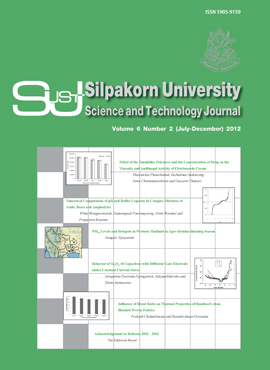PM10 Levels and Hotspots in Western Thailand in Agro-Residue Burning Season
Main Article Content
Abstract
Open burning of agro-residues normally generates a large amount of pollutants which may result inpotential impacts on the ambient air quality and public health. A study of a correlation between PM10 levelsin ambient air and hotspot counts in Western Thailand was conducted to investigate whether the air qualityof Nakhon Pathom Province was influenced by the emission from agro-residue burning. Two high VolumeSamplers for PM10 sampling were installed in Silpakorn University to obtain the representative PM10 levelsin Nakhon Pathom province. The number of hotspots, as the fingerprints of open burnings, was provided bythe NASA’s Earth Observatory website. The hotspot counting was divided into 2 parts; (i) 5-year backwardcounting in the province to investigate the burning season, and (ii) counting in Nakhon Pathom province andupwind-adjacent provinces including Kanchanaburi, Ratchaburi, Pathumthani, Pranakorn Sriayudhaya andSuphanburi in a burning season. Wind directions to the sampling locations were obtained from a HYSPLIT Model. Average PM10 levels found in this study was 88±34 mg/m3, which does not exceed Thailand AirQuality Standard of 120mg/m3. The positive correlation between PM10 levels and hotspot counts was foundat R2=+0.81. This study indicated that air quality in Nakhon Pathom Province was affected by emissionsfrom agro-residue burning.
Downloads
Article Details
References
Baldini, G., Campadelli, P., and Fradegrada, M. (2002). Biomass burning monitoring by scene analysis. In Proceedings of Visualization, Imaging, and Image Processing, Calgary.
Kim Oanh, N. T., Upadhyay, N., Zhuang, Y. H., Hao, Z. P., Murthy, D. V S., Lestari, P., Villarin, J. T., Chengchua, K., Co, H. X., Dung, N. T., and Lindgren, E. S. (2006). Particulate air pollution in six Asian cities: spatial and temporal distributions, and associated sources. Atmospheric Environment, 40(18): 3367-3380.
Klinmalee, A. (2008). The development of assessment procedure for exposure to open rice straw burning emission: a case study of school children in Thailand. AIT Dissertation, No. EV-08-4.
Lawrence, K. C. C., Avelino, A. F., and John, M. L. (2001). Investigating the Haze Transport from 1997 Biomass Burning in Southeast Asia: Its Impact Upon Singapore: Asia. Atmospheric Environment, 35(15): 2723-2734.
Mitra, A. P., Morawska, L., Sharma, C., and Zhang, J. (2002). Chapter Two: Methodologies for Characterization of Combustion Sources and for Quantification of Their Emissions. Chemosphere, 49(9):903-922.
Nakhon Pathom Agricultural Extension Office. (2010). Statistical Data of Agricultural Growing in Nakhon Pathom Province in 2010, Department of Strategy and nformation, Nakhon Pathonm.
National Aeronautics and Space Administration. (2004a) Biomass Burning. [Online URL: https://earthobservatory.nasa.gov/ Library/BiomassBurning] accessed on July 22, 2004.
National Aeronautics and Space Administration. (2004b) Biomass Burning: A Hot Issue in Global Change. [Online URL:https://asd- www.larc.nasa.gov/biomass_burn/Factsheet.pdf.] accessed on August 4, 2004.
Phuong, N. L. (2006). Modeling Impact of Open Rice-Straw Burning Emission on Ozone Air Quality in the Bangkok Metropolitan Region. AIT Thesis, No. EV-06-21.
Smith, K. R. (1987). Biofuels, Air Pollution, and Health: A Global Review, Plenum Press, New York.
The Fire Information for Resource Management System. (2011). Hotspot Count. [Online URL: https://firefly.geog.umd.edu/firemap/] accessed on March 31, 2011.
Tipayarom, D. (2004). Source Characterization for Air Pollution Emission from Open Rice-Straw Burning in Thailand. AlT Thesis, No. EV-04-5.
Tipayarom, D. and Kim Oanh, N. T. (2007). Effects from Open Rice Straw Burning Emission on Air Quality in the Bangkok Metropolitan Region. Science Asia, 33: 339-345.
United State Environmental Protection Agency. (1999). Determination of Polycyclic Aromatic Hydrocarbons (PAHs) in Ambient Air Using Gas Chromatography/Mass Spectrometry (GC/MS). Compendium Method TO-13A.
Yootong, S. (2003). Receptor Modeling for Source Apportionment of Fine and Coarse Fractions of Particulate Matters in Bangkok Metropolitan Region During Rainy Season. AIT Thesis, No. EV-03-31.


